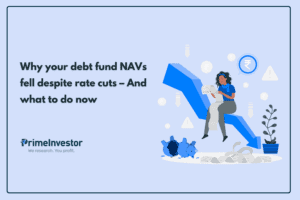- High gilt fund returns in the past 1, 3, 5 years are a function of steadily falling interest rates
- After the 450 bps fall in repo rates and 220 bps fall in g-sec yields over 5 years, rates are at record lows
- Investors trying to time gilt funds today risk nil or even negative returns if rates rise over the next 2-3 years
- Invest in gilt funds only if you are confident of exit before the rate cycle reverses
With interest rates on bank deposits, small savings schemes and most categories of debt funds taking a knock, many investors are on the lookout for that one miracle avenue that will give them high returns with capital safety. Gilt mutual funds, which invest only in government bonds, on the face of it, look very appealing today because of their high past returns.

But is it really possible to get capital safety with double-digit returns? No, it isn’t. Here’s why gilt funds aren’t as straightforward as they look. We’ve answered this through questions we have received over the past couple of months.
Q: SBI deposits are giving me 5.1% and gilt funds are giving a 12-13% return. Isn’t this a wonderful investment opportunity? The Government of India is safer than banks, no?
Government of India bonds are certainly safer than bank deposits. But this doesn’t mean that mutual funds that invest in government bonds (gilts) are ‘safe’. If you define safety as protection of your capital, the money you invest in a gilt fund isn’t ‘safe’ and is subject to market volatility.
On returns, you are comparing gilt fund returns for the last one year to the returns you will get in the next one year from the SBI deposit. You can’t compare past returns on one product to future returns on another. While gilt funds have given 12-13% in the last one year, there’s no way to tell if they’ll beat the SBI deposit in the next one year.
Q: So how can I know the returns for the next 1 year or 3 years on gilt funds?
Future returns from gilt funds are not predictable. Like other debt mutual funds, gilt funds make their returns from two sources – the interest received on the g-secs they hold and the movements in the prices of those g-secs which lead to appreciation/depreciation in their NAV.
While you can gauge the interest receipts that are likely on gilts from their prevailing yield in the market, it is difficult to gauge how interest rates will move in the next one year or three years. If interest rates for new government borrowings fall, gilt prices will move up and you will get NAV appreciation in gilt funds.
If interest rates for new government borrowings rise, gilt prices can decline and you can experience NAV losses from your gilt fund. Gilt fund NAVs fall when market interest rates rise because, when new g-secs become available with better rates, no one wants to lock into the older ones with lower rates. The longer the duration of g-secs held by a fund, the more the loss it suffers when rates go up.
To illustrate, assume that the current yield on a 10-year g-sec with a current market price of Rs 1000 is 5.8%. If the government is able to borrow new 10-year money at 4.8%, the price of your g-sec will shoot up to Rs 1078, because people will scramble to buy your g-sec offering high rates. In contrast, if the borrowing cost for the government were to rise to 6.8%, the market price of your g-sec will fall to Rs 929 because investors will rush to sell this security and buy the new one that offers better rates. Movements in g-sec interest rates in the market therefore affect the NAVs and returns of gilt funds. Today, in fact, a larger proportion of the gilt fund returns that you see are attributable to NAV appreciation rather than their interest receipts.
Unlike bank deposits, you can make a capital loss on a gilt fund if interest rates rise, though the Government will never default on its obligations.
Q: But won’t interest rates in India fall for the next one to three years? After all, the recovery from Covid will not be fast.
They could, but there’s no certainty about it. While many debt fund managers are confidently predicting that more MPC rate cuts are likely, and that market interest rates will follow suit, calling the direction of bond markets is as dicey as calling the direction of stock markets. Fund managers have been known to get such calls wrong quite often in the past.
Looking at it dispassionately, the MPC may cut rates further if India’s GDP growth over the next few quarters pans out worse than expected, and inflation remains muted. It may hold rates if it sees that its past rate cuts have not made much of a difference to growth, or that inflation is staying in its comfort zone of 4-6%. The MPC can hike rates, though this looks quite unlikely, if the recovery from Covid proves V-shaped and is accompanied by rising inflation.
Market yields on g-secs do not faithfully follow MPC cues. For instance, between March 20 2020 and June 16 2020, MPC sharply cut its repo rates which declined by 115 basis points from 5.15% to 4%. But the 10-year g-sec in this period saw two-way movements.
As an investor in gilt funds, you will need to worry not just about MPC actions, but also about how interest rates on g-secs will move, as it is this which decides your gilt fund returns. Market yields on g-secs do not faithfully follow MPC cues. For instance, between March 20 2020 and June 16 2020, MPC sharply cut its repo rates which declined by 115 basis points from 5.15% to 4%. But the 10-year g-sec in this period saw two-way movements. It saw its yield move up from 6.2% in March to 7% in April, fall back to 5.7% in May and go up slightly to rule at 5.8% currently.
Apart from trying to pre-empt MPC actions, gilt yields respond to many other factors such as inflation readings, the demand for g-secs from banks, FII investments and pull-outs, the Centre’s fiscal deficit projections and the size of government borrowings expected to hit the market in the coming months. As these variables are fluid, it is far more difficult to predict g-sec moves than MPC actions.
Q: So are you saying gilt funds are not a good investment?
Not at all. If you know how to time your entry or exit from them, they can be a very good investment. For instance, between January 2015 and June 2020, the MPC has cut its repo rate by a whopping 450 basis points from 8.5% to 4%. G-sec yields in this period have fallen from 8% to 5.8%. As g-sec prices have appreciated, gilt fund investors have made a killing with a 9% plus CAGR in the last five years. Similarly, gilt funds have made 12-13% in the last one year based on sharp Covid-related rate cuts, beating every other debt avenue.
But given that these returns are due to the sharp fall in interest rates, you cannot extrapolate these returns into the next 1, 3 or 5 years. In the case of stocks, when timing your entry, you always evaluate how much upside there is to stock prices compared to the downside. The same holds good for gilts too. With repo rates already at a record low of 4% and the 10-year g-sec below 6% after falling in the last 5 years, the upside to rates from here appears to be higher than the downside.
Of course, if you strongly believe that repo rates and gilt yields will fall sharply in the next one year and are confident of getting out of gilt funds before the next upcycle arrives, you can certainly invest in gilt funds.
Otherwise, you should be willing to hold them through ups and downs for longer periods of 5 year or more and use SIPs if such investments are part of your long-term portfolio. Here again, expect regular debt returns, and not the kind of returns you are seeing now.
Q: This seems dicey. Is there a good time to invest in gilt funds?
Yes, there is. It is better to invest in gilt funds when interest rates have been rising steadily in the last 3 or 5 years and look likely to peak out in the near future. While predicting such peaks is dicey, you can use the 10-year gilt yield as a guide. Looking at the history of interest rates in India, the 10-year gilt yield has usually topped out at 8-8.5% and bottomed out at 5-6%. We are closer to the lower end of this band now.
Usually, when past returns for gilt funds are looking very attractive that is an unfavourable time to invest in them. It is when past 1-3 year returns on gilt funds are negative or in low single digits, that it is a good time to invest.
Q: I’ve lost a lot of capital from investing in other types of debt funds with credit risks. With gilt funds, I can avoid volatility, right?
Not really. Gilt funds can subject you to pretty big losses too, if you invest in them just before a rising rate cycle. If you look back at the last ten years, in their worst year (2009) many gilt funds lost 7-10% of their NAV. In their worst quarters (January-April 2009, July-September 2013) they lost 12-13%. There have even been occasional phases where they lost 10% in a single month. At the other extreme, in their best years (like 2008-09), some gilt funds delivered as much as 23%. There are also months where they returned 15-17%. These numbers go to show just how volatile a category this is, as far from a bank deposit as possible!
Q: Are gilt funds suitable for parking emergency money? Can I use them as liquid fund substitutes?
No, the very volatility of their NAV makes gilt funds unsuitable for parking your emergency money. Making money from a gilt fund requires careful timing of entry and exit, which is not possible with your emergency money.
Q: Okay then, where should I invest today if I want fixed income with a government guarantee?
Post office schemes are your best bet to have absolute capital safety with a government guarantee.
Q: So, should I not invest in gilt funds at all?
You can. PrimeInvestor has recommendation on them for 5-year plus time frames. They are a good credit-risk-free debt option for your long-term asset-allocated portfolios. We’d only like to drive home the point that gilts funds can be volatile, they need to be timed well if you are investing for the short term and they can suffer NAV losses even over 1-3 year periods.







15 thoughts on “Is it the time to buy gilt funds?”
Neat writing on Gilt funds and when to invest and when not to.
Got this article after spending more time in Google.
Now had a very clear picture on Gilt fund investment.
Thanks.
If I were to invest lumpsum in debt funds what is the avenue today as interest rates haven fallen? Note its either 20 or 30 taxslab in terms of taxes. All the limit upto taxable limit, plus80C etc is covered in FD investments etc. Is it wise to invest in ICICI prudential credit risk fund now with the AA and AAA papers having wide difference in yields?
Another query in raising interest rates is it better to pick floating g rate investments verses ultra short term investments?
Hello sir,
If you are a subscriber, please write to us using this form for fund-specific queries. You can also use our MF Review Tool to know our buy/sell/hold calls on funds.
Thanks,
Bhavana
Firstly, thank you for such a insightful article on gilt.
What is your view on doing SIP for long term say ten years plus and then followed by SWP from the same fund for next 15-20 years. Will this strategy work?
Can we make this fund a part of our core debt portfolio for retirement goal. If yes, then what should be the allocation to Gilt.
Yes, you can, provided you don’t get shaken by the volatility during SWP period. Allocation – entirely depends on individual’s portfolio and exposure to other debt products. Cannot be generalised. thanks, Vidya
Excellent article, very nicely explained. Thanks
Dear Madam, I have heard the same negative story about Gilt funds and Gold at every given point of time in last few years by all the columnist and advisors. But everyone has been proven wrong. Agree with the points written, but we always look at historical interest rate and expect the interest rates to move up. But given the condition of the economy the interest rate may remain the same or reduce for a long time to come like it is in so many other countries. If the interest rate goes up not only Gilt funds but the other debt funds will also face the negative returns isn’t it? Yes there will be a blip in returns if interest rate goes up but at least there is no Credit risk in Gilt funds compared to other debt funds where if a company defaults and goes bankrupt, money is gone for ever. This has happened already last 2 years and no guarantee it will not happen again (in fact more likely now). What happens if I buy T-Bills and G-sec directly from the market? If I keep it to maturity I will surely not loose money. I think an article how to buy T Bills and G-secs directly from market will be more helpful instead of scaring people about Gilt funds. Thanks. Best Regards
Sir,
The article only makes the point that timing is important in gilt funds and doesn’t really try to “scare” people off the category. Primeinvestor in fact has a gilt fund recommendation in its 5 year plus portfolio. Articles here are targetted at all sorts of investors both savvy and non savvy. We believe all asset classes have a timing aspect. A great investment at one vuation becomes a poor investment at another. I personally have been quite positive on gold since 2008 so do not belong to the category of analysts who are permanently bearish or bullish on any asset.
We will certainly cover direct investments in gilts in a future article (when the time is better)..thank you for the suggestion.
I can sound bit contrarian but I think there are some good credit risk fund like idfc credit risk fund where we can park money for more than 1 year. In credit risk there is no issues regarding interest rate cycles.
Excellent article, very well explained. We got to wait for the interest rate cycle to turn upside and to show consistency in the upside trend to invest in gilts
Thank you. Yes absolutely.
Thanks, would like to see a similar report on Banking & PSU fund and Arbitrage fund.
Sure sir. thanks, Vidya
Very good analysis of gilt funds.
In the near future that is within next two or three years interest rates will begin to rise.
Hence, investment in gilt funds is not advisable. Long term investors can directly buy Government bonds directly when offered by RBI to have stable returns.
Sudhakarudu
Comments are closed.